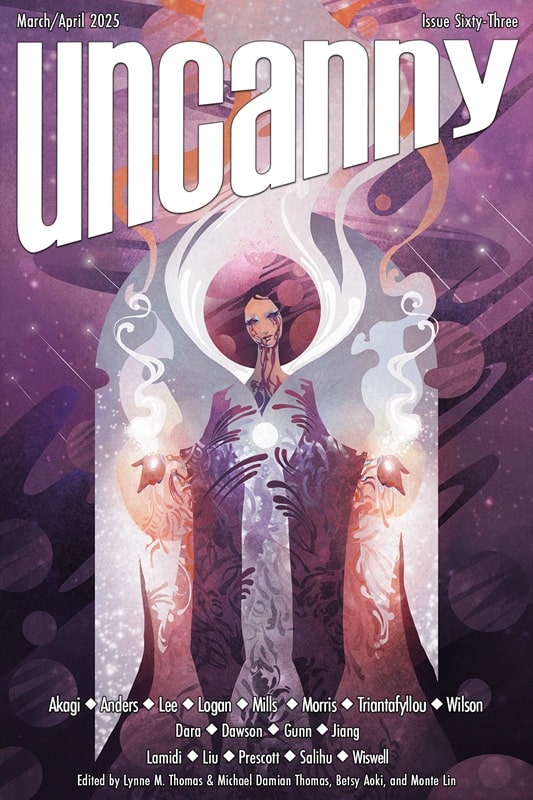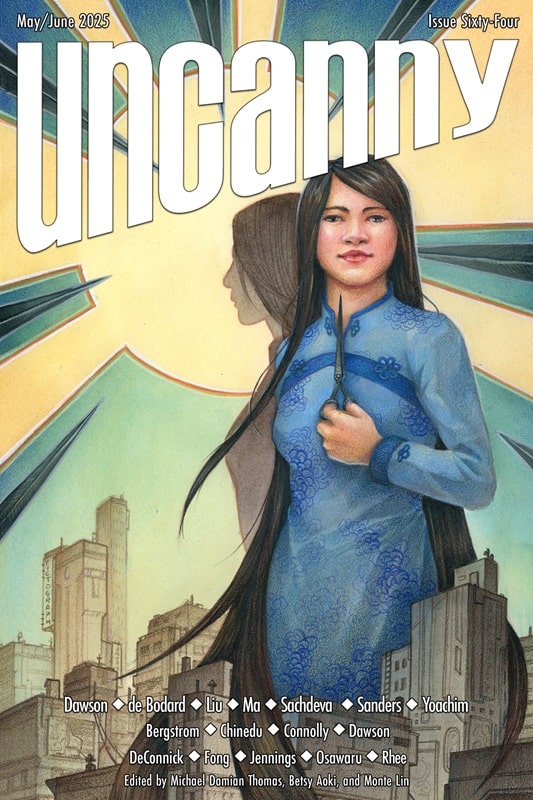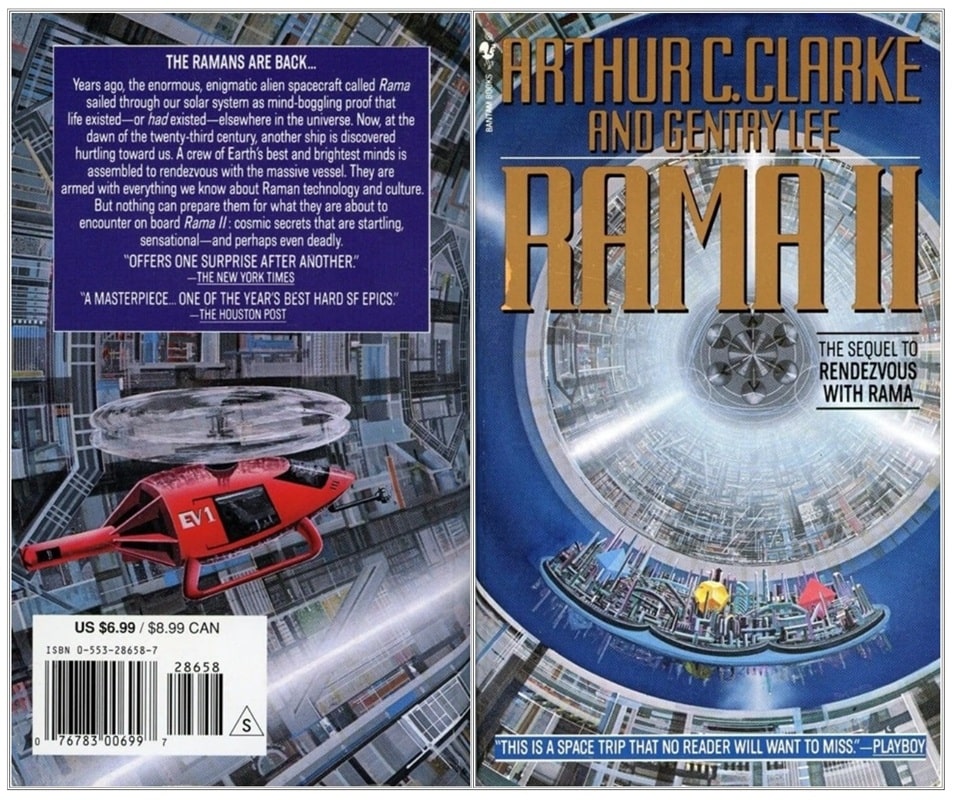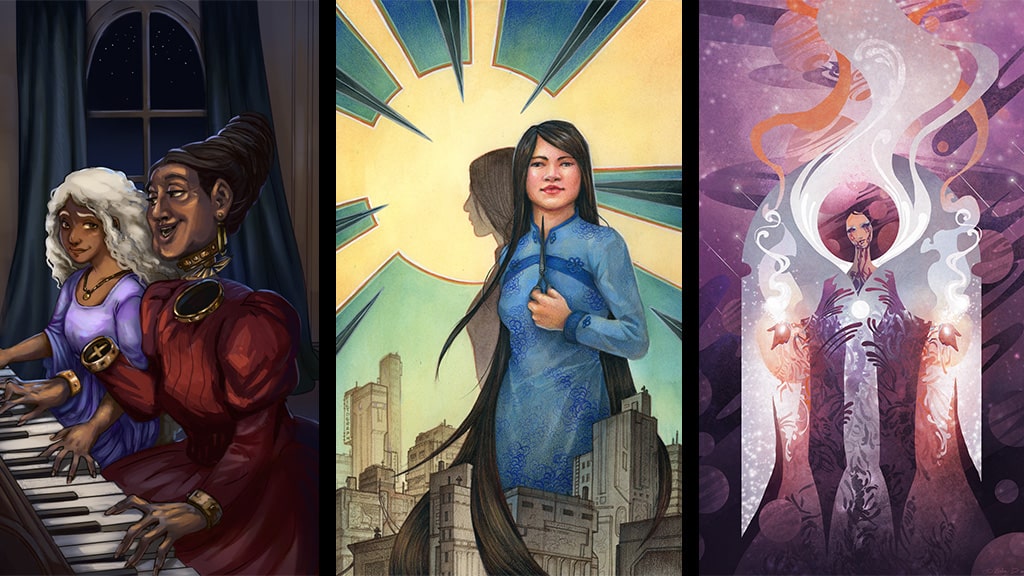AI Could Not Write These Stories
 |
 |
Uncanny Magazine, issues 63 & 64, March/April and
May/June 2025. Covers by Galen Dara and Grace P. Fong
With every issue, Uncanny Magazine brings you stories, poems, essays, interviews, and podcasts, all made by actual people! Now more than ever, it is important to support creators who are working to make the art you love. Check out our Uncanny Magazine Year 12: Fly Forever, Space Unicorns! Kickstarter for subscriptions and cool backer rewards, and help us spread the word!
Science fiction has long been enamored with artificial intelligence. As far back as Samuel Butler’s 1872 novel Erewhon, writers have speculated on how machines might develop consciousness and what the world might look like if they did. In modern fiction, we see a vast range of possibilities — stories where robots fall in love, stories where AI can determine anyone’s true cause of death, stories of experimental prototypes reading Western literature as dystopia looms, stories where simulations let us talk to our loved ones after they’ve passed. In R.S.A Garcia’s “Tantie Merle and the Farmhand 4200” artificial intelligence comes in the form of a loyal farmhand companion, made of nanites, repeatedly eaten by a goat.
In the time since Erewhon was written, we’ve made a lot of technological advances. There are medical diagnostic algorithms, programs that generate images in various styles, and increasingly sophisticated chatbots. As Martha Wells pointed out in her recent interview in Scientific American, humans love to anthropomorphize, and fictional depictions of advanced artificial intelligences often reinforce that tendency. But in reality we are nowhere near the level of sentient, intelligent machines.

There’s a scene in Rama II (by Arthur C. Clarke and Gentry Lee) where the characters encounter a room with an assortment of items — a tube of toothpaste, a watch, a nail file, etc — that were made by aliens who only had images of the items to work from. They were shallow imitations that were quite convincing on the outside, but totally wrong beyond a surface level similarity, particularly in the case of the toothpaste tube, which contained a paste so foul tasting that it was useless for cleaning teeth. It was a mimicry of form without the underlying content, which is quite similar to what happens when generative AI tries to write stories.
In his Uncanny Magazine essay “Breakout, Ripoff, Genre: How Fiction Outgrows Originality” John Wiswell writes:
Art is more about conversation than originality. What lived experiences move you? What bits of stories have stuck to your heart? Those become living, beating organs in our work.
Generative AI has no lived experiences, and it is not moved by the stories it ought to be in conversation with. It has no heart, so it generates stories that have no heart. Uncanny Magazine, on the other hand, is filled with beautifully crafted stories, imaginative and poignant, that elicit strong emotions and challenge beliefs. Stories that are full of heart. Stories that make you feel. Heartwarming stories of hope after the apocalypse, heartbreaking stories of grief.
In his New Yorker article “Why A.I. Isn’t Going to Make Art,” Ted Chiang suggests that art is something that results from a series of many choices made by the artist — a process that is disrupted once generative AI is involved. For fiction, writing even a short story involves making thousands of choices, about plot and character, story structure and voice, even down to the selection of individual words. And while generative AI might be able to mimic some of these choices at a surface level, the results will be, at best, derivative — either an average of many sources or a shallow mimicry of a specific style.

I love this framework for thinking about stories, in terms of the choices an author makes. It is often challenging to decide what goes into a story and what doesn’t, and authors often talk about why they wrote a story the way they did. For instance, P. Djèlí Clark talks about “How to Raise a Kraken in Your Bathtub” in one of his blog posts:
My own story is quite intentionally set in the late 19th century, most specifically Victorian England. With Jules Verne as my muse, it has its share of steampunk elements. But I’m also a fantasist at heart, so there are also mermen. Because why not? One thing about me – I’m gonna gaslamp the heck *outta my punk every time. Colonialism is another evident theme in the story, because how [can] it not be given the age? And it was a topic of Jules Verne’s work. When I visited Nantes I was reminded of its other history as a key player in the trans-Atlantic slave trade. So the story seems even more fitting. And that seemingly absurd title? Nope, not a metaphor. In this story you will literally get a kraken and a bathtub. You’re welcome.
There is a blend of several topics here — external sources of inspiration, personal tendencies, trains of thought that lead down various research rabbit holes. These are the kinds of choices that make a story interesting, and one of the things I love about doing the interviews at Uncanny is hearing about the choices and the process behind each author’s story.

“¡Sangronas! Un Lista de Terror” by M. M. Olivas a powerful exploration of community, essentialism, and pushing back against the rules. In her interview, Olivas discusses why she chose to structure the story as a list of rules:
I wanted to show the fallacy of it. Its nuances — how having rules can protect you, find community, help discover yourself — and how its rigidity crumbles at the slightest provocation — who enforces the rules and why, who’s barred out, how no one can ever truly follow each rule. I wanted the list to be so overbearing and present that it became arbitrary.

Arkady Martine also talks about structural choices in her interview for “Three Faces of a Beheading,” with a focus on trying to evoke a specific reading experience:
I’m also very interested in cut-up and juxtaposition as techniques: putting unexpected elements next to one another creates powerful effects for the reader.
“Stitched to Skin like Family Is” by Nghi Vo is a poignant tale of lost loved ones, vengeance, and magical clothes. Vo’s interview talks about bringing together several different sources of inspiration:
Some of it came from this thin quilt my maternal grandmother sewed, which had these bright patches of turquoise and raspberry fabric, and some of it came from a brief research jag I went on for the Bloody Benders, the serial killing family from Kansas. Some of it came from the idea of how easy it was to just disappear less than a hundred years ago, and some of it came from my love of old clothes and the history that travels invisibly with them.

All of these authors were drawn to different ideas, and made thousands of choices about how to execute the story. Choices based on their lived experiences and interests, their literary influences and their vision for what they wanted to achieve with their story. The results are powerful, interesting stories, that no one else — and certainly no AI — could have written in quite that way.
This essay highlights only a small sample of the work that has appeared in Uncanny in recent years, but if you love the magazine, please support us. We’re currently running our Uncanny Magazine Year 12 Kickstarter to bring you another year of amazing stories, poems, essays, interviews, and podcasts. Check it out, subscribe, and help us spread the word!
Uncanny Magazine Interviewer Caroline M. Yoachim is a prolific author of short stories, appearing in Asimov’s, Fantasy & Science Fiction, Uncanny, Beneath Ceaseless Skies, Clarkesworld, and Lightspeed, among other places. She has been a finalist for the Hugo, World Fantasy, Locus, and multiple Nebula Awards, and her stories have been reprinted in multiple year’s best anthologies and translated into several languages. Yoachim’s debut short story collection, Seven Wonders of a Once and Future World & Other Stories, came out in 2016. Her last article for us was Uncanny Futures.

(Will comment about the AI creativity and experiential angles of your article as soon as my brain is not so burnt out, because you make excellent points. For now, though, “Tantie Merle and the Fadmhand 4200” is platinum, and now I want to track down everything else R.S.A. Garcia has written. Thank you for including that link.)
It’s becoming clear that with all the brain and consciousness theories out there, the proof will be in the pudding. By this I mean, can any particular theory be used to create a human adult level conscious machine. My bet is on the late Gerald Edelman’s Extended Theory of Neuronal Group Selection. The lead group in robotics based on this theory is the Neurorobotics Lab at UC at Irvine. Dr. Edelman distinguished between primary consciousness, which came first in evolution, and that humans share with other conscious animals, and higher order consciousness, which came to only humans with the acquisition of language. A machine with only primary consciousness will probably have to come first.
What I find special about the TNGS is the Darwin series of automata created at the Neurosciences Institute by Dr. Edelman and his colleagues in the 1990’s and 2000’s. These machines perform in the real world, not in a restricted simulated world, and display convincing physical behavior indicative of higher psychological functions necessary for consciousness, such as perceptual categorization, memory, and learning. They are based on realistic models of the parts of the biological brain that the theory claims subserve these functions. The extended TNGS allows for the emergence of consciousness based only on further evolutionary development of the brain areas responsible for these functions, in a parsimonious way. No other research I’ve encountered is anywhere near as convincing.
I post because on almost every video and article about the brain and consciousness that I encounter, the attitude seems to be that we still know next to nothing about how the brain and consciousness work; that there’s lots of data but no unifying theory. I believe the extended TNGS is that theory. My motivation is to keep that theory in front of the public. And obviously, I consider it the route to a truly conscious machine, primary and higher-order.
My advice to people who want to create a conscious machine is to seriously ground themselves in the extended TNGS and the Darwin automata first, and proceed from there, by applying to Jeff Krichmar’s lab at UC Irvine, possibly. Dr. Edelman’s roadmap to a conscious machine is at https://arxiv.org/abs/2105.10461, and here is a video of Jeff Krichmar talking about some of the Darwin automata, https://www.youtube.com/watch?v=J7Uh9phc1Ow